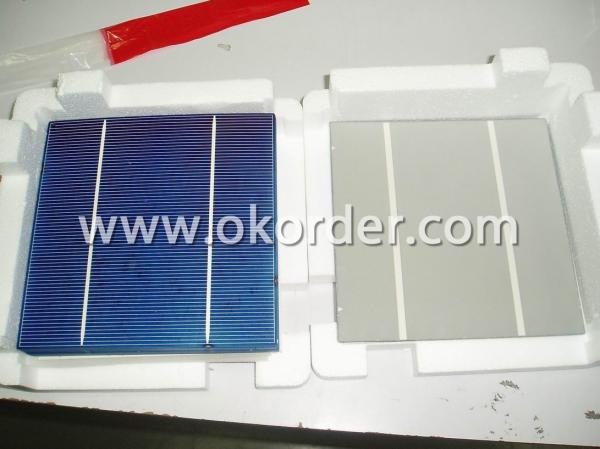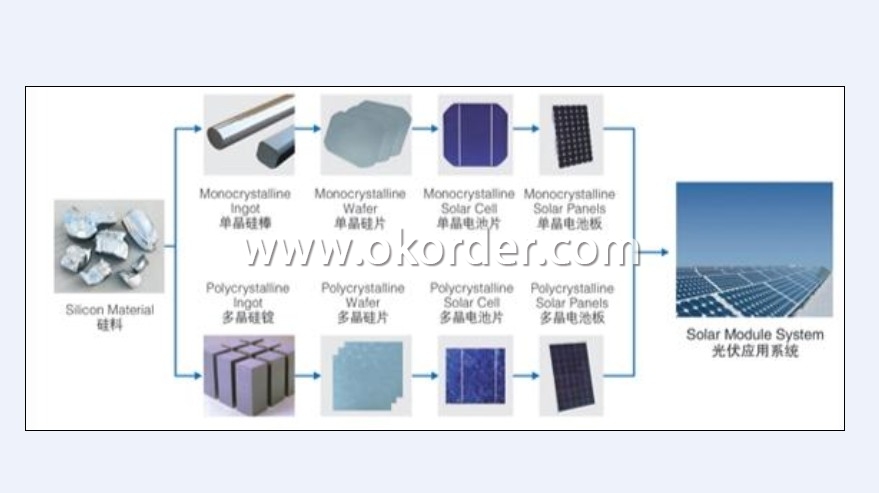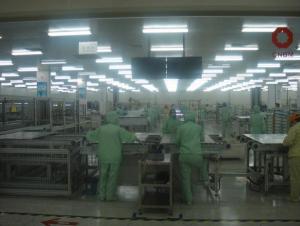High Quality Poly Solar Cell 156mm with TUV,CE Certification
- Loading Port:
- Tianjin
- Payment Terms:
- TT or LC
- Min Order Qty:
- 40000 watt
- Supply Capability:
- 1000 watt/month
OKorder Service Pledge
OKorder Financial Service
You Might Also Like
Details Of Poly Solar Cell 156mm
Specifications Of Poly Solar Cell 156mm
1.Mechanical data and design
Format | 156 mm × 156 mm ± 0.5 mm |
Thickness | 210 μm ± 40 μm |
Front(-) | 1.5mm bus bars (silver),blue anti-reflection coating (silicon nitride) |
Back (+) | 2.5 mm wide soldering pads (silver) back surface field (aluminium) |
2.Temperature Coefficient of Cells
Voc. Temp . coef.%/K | -0.351%/K |
Isc . Temp . coef.%/K | +0.035%/K |
Pm. Temp. coef.%/K | -0.47%/K |
3.Electrical Characteristic
Efficiency (%) | Pmpp (W) | Umpp (V) | Impp (A) | Uoc (V) | Isc (A) | FF (%) |
17.25 | 4.197 | 0.524 | 7.992 | 0.62 | 8.458 | 80.03% |
17 | 4.137 | 0.524 | 7.876 | 0.619 | 8.353 | 80.01% |
16.75 | 4.076 | 0.522 | 7.81 | 0.617 | 8.286 | 79.73% |
16.5 | 4.015 | 0.518 | 7.746 | 0.613 | 8.215 | 79.73 |
16.25 | 3.955 | 0.515 | 7.683 | 0.61 | 8.144 | 79.61% |
16 | 3.894 | 0.512 | 7.613 | 0.608 | 8.075 | 79.31% |
15.75 | 3.833 | 0.51 | 7.534 | 0.605 | 8.058 | 78.62% |
15.5 | 3.772 | 0.508 | 7.453 | 0.604 | 8.02 | 77.87% |
15.25 | 3.771 | 0.505 | 7.35 | 0.604 | 9.997 | 76.83% |
15 | 3.65 | 0.503 | 7.271 | 0.604 | 7.989 | 75.64% |
14.5 | 3.529 | 0.499 | 7.067 | 0.604 | 7.988 | 73.14% |
14 | 3.407 | 0.499 | 6.833 | 0.604 | 7.833 | 72.01% |
4.Intensity Dependence
Intensity [W/m2] | Isc× [mA] | Voc× [mV] |
1000 | 1.00 | 1.000 |
900 | 0.90 | 0.989 |
500 | 0.50 | 0.963 |
300 | 0.30 | 0.939 |
200 | 0.20 | 0.920 |
Advantage Of Poly Solar Cell 156mm
1: High quality cell, Level A cell (14%—17.5%)
2.Dimensione:156*156mm Diagonal:200mm
3: Qualified certification: TUV,CE certification.
4: Warranty: five years for whole unit
Usage/Application Of Poly Solar Cell 156mm
Packaging & Delivery Of Poly Solar Cell 156mm | |
Packaging Detai | Packaging Detail:Export Carton and Pallet or under customer request. |
Delivery Detail:10-20days | |



Latest research progress of Polymer Solar Cells
Compared with mature inorganic silicon solar cells from its conversion efficiency and stability, Polymer Solar Cells is still in the development stage. However, due to the advantages of having a light weight, low cost, flexible devices can be made, and a wet film formation (spin coating, ink jet printing and screen printing) technology and other large area, the organic polymer solar cells become one of the hottest areas of research.
Photoelectric conversion efficiency of solar cells is determined by the open-circuit voltage of the battery, short-circuit current, and fill factor, so how to improve the aforementioned three factors, the conversion efficiency of solar cells is a key factor in increasing.
A joint research team from the University of California and the University of Cambridge consisting proposed PIPCP in recent journal Advanced Materials: PC61BM conjugated polymer ─ fullerene heterojunction solar cells latest research body, proposed a lifting battery open circuit voltage the method can significantly improve the photoelectric conversion efficiency of the device.
The paper pointed out that when the organic material absorbed photon excited state is formed, the excited state is seen as the static electricity in a combination of electrons and holes, known as excitons. Since the exciton properties of the organic semiconductor, the driving force of the charge separation in a solar cell is the donor and acceptor materials, the energy difference. Electronic circuit voltage depends on solar photovoltaic bandgap and bandgap is the recipient of the lowest unoccupied molecular orbital (LUMO) and to the body between the highest occupied molecular orbital (HOMO) energy difference.
Receptor lowest unoccupied molecular orbital wave function of the body and to the highest occupied molecular orbital overlap between the interface can create a form, this interface morphology and related electronic open-circuit voltage, called the charge transfer state (CTS). In fixed offsets, energy and electronic charge transfer state open circuit voltage linear relationship, even with the temperature close to the same value obtained when 0K, which shows the energy charge transfer state may limit the open circuit voltage of the electron. By reducing energy loss in the electronic band gap to the open circuit voltage, can effectively enhance the photoelectric conversion efficiency of the organic polymer solar cell.

- Q:How do solar cells perform in areas with extreme temperature fluctuations?
- Solar cells can be affected by extreme temperature fluctuations. High temperatures can cause solar cells to become less efficient and generate less electricity, while very low temperatures can reduce their ability to function optimally. However, advancements in technology and the use of materials that are more resistant to temperature changes have improved the performance of solar cells in areas with extreme temperature fluctuations. Additionally, proper installation and maintenance can help mitigate the impact of temperature fluctuations on solar cell performance.
- Q:What is the most commonly used material for solar cells?
- Because of the commercialization of solar cells. The variety of solar cells includes monocrystalline silicon solar battery, poly silicon solar cell, non crystalline silicon solar battery, there are also,cadmium, copper indium, etc.
- Q:How do solar cells affect the grid?
- Solar cells affect the grid by generating electricity from sunlight and feeding it into the grid, reducing the reliance on traditional power sources. They contribute to a more sustainable and decentralized energy system, helping to reduce greenhouse gas emissions and dependence on fossil fuels. However, their intermittent nature can pose challenges for grid stability and require additional infrastructure investments for integration.
- Q:What is the role of bypass diodes in solar cell systems?
- The role of bypass diodes in solar cell systems is to prevent the loss of power due to shading or damage to individual solar cells. These diodes provide an alternate pathway for the flow of current, allowing the unaffected cells to continue generating electricity even if some cells are blocked or not functioning optimally. By minimizing the impact of shading or cell failure, bypass diodes help to maintain the overall efficiency and performance of the solar cell system.
- Q:What is the impact of solar cells on reducing energy waste?
- Solar cells have a significant impact on reducing energy waste as they harness clean and renewable energy from the sun, thus reducing the need for fossil fuels. By converting sunlight into electricity, solar cells provide a sustainable and environmentally friendly alternative, reducing greenhouse gas emissions and dependence on non-renewable energy sources. This helps combat climate change and promotes a more efficient use of energy, ultimately decreasing energy waste.
- Q:Can solar cells be used in agriculture?
- Yes, solar cells can be used in agriculture. They can be used to power various equipment and systems in farming, such as irrigation systems, ventilation systems, and lighting for greenhouses. Solar energy can also be utilized to charge batteries for electric farm vehicles and tools, reducing reliance on fossil fuels and minimizing carbon emissions. Additionally, solar panels can be mounted on rooftops or installed as shade structures to provide shelter for livestock while generating clean energy.
- Q:How do solar cells affect property value?
- Solar cells can positively impact property value by increasing its market appeal and attractiveness to potential buyers. The presence of solar cells signifies energy efficiency, lower electricity costs, and environmental consciousness, which are all desirable qualities in a property. Additionally, solar cells can potentially generate income through net metering or selling excess energy back to the grid, further enhancing the value of the property.
- Q:What happens to excess electricity generated by solar cells?
- Excess electricity generated by solar cells can be stored in batteries for later use, or it can be fed back into the grid to be used by other consumers.
- Q:How can I understand the working principles of solar cells?
- Read as many books as you can.
- Q:How do solar cells perform in areas with frequent earthquakes?
- Solar cells are designed to withstand earthquakes to some extent, but the performance can be affected depending on the severity of the earthquake. If the solar cells are properly installed and secured, they can generally withstand moderate earthquakes without significant damage. However, in areas with frequent and strong earthquakes, additional measures like reinforced mounting systems may be necessary to ensure the long-term performance and durability of the solar cells.
1. Manufacturer Overview |
|
|---|---|
| Location | SanShui City, Guang Dong, China. |
| Year Established | 2009 |
| Annual Output Value | Above 10 billion RMB |
| Main Markets | Mid East;Western Europe;North America;Southeast Asia |
| Company Certifications | TUV ISO9001;SGS |
2. Manufacturer Certificates |
|
|---|---|
| a) Certification Name | |
| Range | |
| Reference | |
| Validity Period | |
3. Manufacturer Capability |
|
|---|---|
| a)Trade Capacity | |
| Nearest Port | Zhuhai, Foshan |
| Export Percentage | 0.4 |
| No.of Employees in Trade Department | about 600 |
| Language Spoken: | English;Chinese; |
| b)Factory Information | |
| Factory Size: | 66666.7m2 |
| No. of Production Lines | 12 |
| Contract Manufacturing | OEM Service Offered;Design Service Offered |
| Product Price Range | USD 0.3-0.45/Wp |
Send your message to us
High Quality Poly Solar Cell 156mm with TUV,CE Certification
- Loading Port:
- Tianjin
- Payment Terms:
- TT or LC
- Min Order Qty:
- 40000 watt
- Supply Capability:
- 1000 watt/month
OKorder Service Pledge
OKorder Financial Service
Similar products
New products
Hot products
Related keywords



























